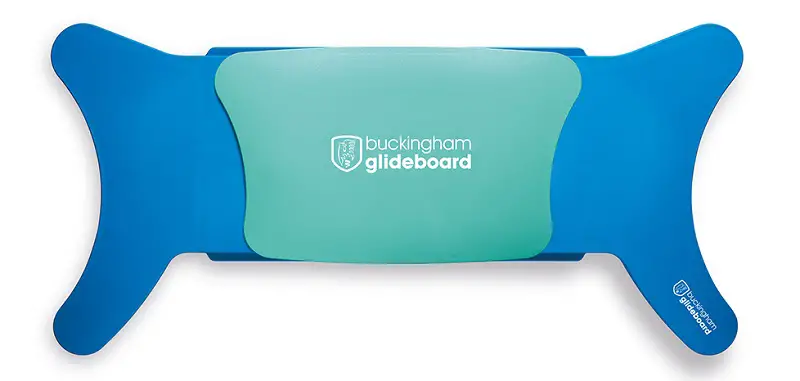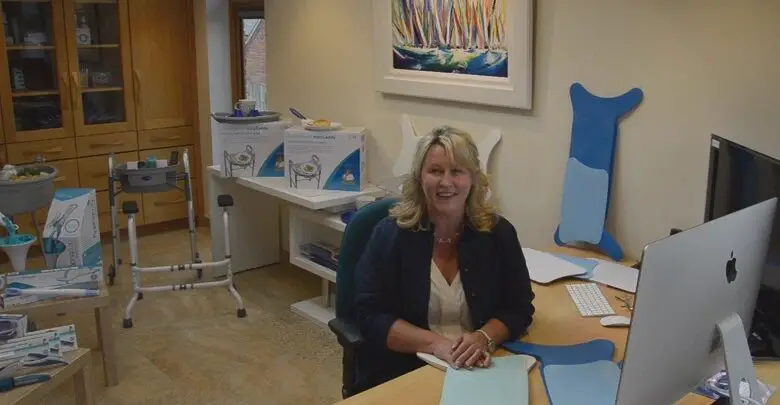
The story behind the NEW and innovative Glideboard transfer aid
The Glideboard: A Better Way to Transer
The Glideboard is something special. Available to buy at the Disability Horizons Shop.
What Makes It Different?
- It has a seat that glides smoothly. This means it moves without jerking or sticking.
- Its special design is has a unique shape. This helps keep it steady and easy to use.
Why You’ll Love It
- It is light to carry, less than 1.5kg.
- It is also strong and supports you well.
The Glideboard is perfect for anyone looking for easier and safer ways to move. Try it today and see how it can change your life!
Chris Buckingham, who founded disability living aids company Buckingham Healthcare after 15 years of experience as an occupational therapist, tells us about how the Glideboard came about and her passion for helping disabled people to live independently by solving problems.
Head to the Disability Horizons Shop NOW to buy the innovative Glideboard.
What made you decide to become an occupational health therapist?
Actually, occupational therapy (OT) was my second career. I originally trained in law but quickly realised that it wasn’t for me.
I decided to take a second degree in psychology and whilst undertaking some work experience in a psychiatric unit I came across an OT doing some amazing therapy sessions with her very complex patients.
She triggered my interest and I applied to Southampton University and was accepted on their degree program.
Occupational therapy is one of those professions that most people have never heard of. It is only when you need one that you begin to understand what it is that they do.
I wasn’t totally sure what the role involved, but once I started learning and doing placements, I discovered that I loved it and really thrived.
As an OT, you’re not just dealing with the physicality of a person, you’re considering their mental health, which my psychology experience helped with, as well as pretty much every aspect of their lives.
You have to look at everything – home adaptations and building work, helping them to get back to work, manage their daily living, enabling them to socialise and everything else in between. It’s about the whole person – their lives, beliefs and aspirations. So, for me, it was perfect.
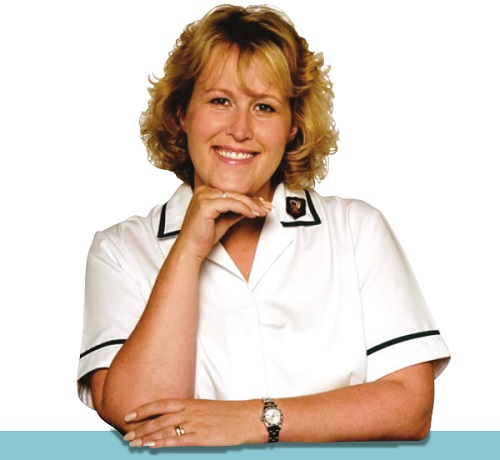
What did you love most about being an OT?
The people – they are at the heart of it. My passion is all about understanding a person, accepting them exactly as they are, and then fulfilling the goals that they have, even if they may be unusual. That’s what I have always tried to do.
I used to challenge the medics on this – and in those days that wasn’t something you did as the consultants were viewed as demi-gods and the ward managers often saw people as numbers in beds. One example was with an elderly woman I visited when I was a junior as part of a social services community team.
When I visited her at home, I realised that she needed help. She was totally unkempt, had rubbish bags everywhere, rats in her kitchen, was sleeping on a mattress with a hole in it, her toilet was broken and overflowing and there was no food in the house.
She was incredibly engaging to me but clearly couldn’t cope. We admitted her to the hospital and carried out the usual assessments. At times, she was quite formidable, and not responsive to the other staff.
The consultant said she should go to the psychiatric ward for evaluation as she was withdrawn with possible underlying learning disabilites, but I knew there was more to her and her story. So I persuaded him to keep her on the ward.
I realised that she was being dismissive because she couldn’t hear anything and needed hearing aids. She was withdrawn because she couldn’t communicate. Once that was solved, she started to eat and drink again properly.
At the next ward round, the consultant said she was ready to go home, but I still knew she wasn’t ready and again persuaded him to increase her stay by another week for further assessments.
Through talking to her and trying to understand her story and how she had come to that point where she was not coping, I discovered that a ‘family friend’ was doing her shopping and was also cashing in cheques signed by her. He was buying her food that wasn’t suitable for her diabetes and this, in turn, had made her housebound.
Her social housing was in such as state because she didn’t know who to call to repair the toilet, the oven and the bathroom when it broke. She didn’t have a phone and with no other friends or carer input she had just carried on as everything deteriorated around her.
Once the full story emerged and the relevant support team was in place, she moved into a lovely one-bedroom flat in a supportive community, overlooking the river. I went to visit her about a year later and she was sat with new friends chatting and laughing. That’s what being an OT is all about, changing people’s lives for the better.

You’ve worked in a range of occupational health settings and with a number of different people. Tell us about your experiences over more than 15 years.
When training to become an OT and in the first few years of work, you tend to do a little bit of everything. You get to rotate departments whilst your skills are evaluated and signed off. You can then specialise and work up the ranks to a senior. I ended up doing it all.
Whilst training, I worked in surgical, stroke recovery, orthopaedic and terminal care, where I moved to senior fairly quickly.
My first role as a senior was in discharge planning, where the focus was on doing an assessment of the patient on the ward, at home, and also deciding on the provision of essential equipment.
I was charged with getting people home as quickly as possible. But for me, it was more important to get them to a place where not only would they go home, but also learn new skills to maintain their independence and not have to come back into hospital.
I next worked as a commissioning therapist in intermediate care. This was a six-week rehab program for people who needed more support. It was fast-paced and an all-inclusive, multidisciplinary approach to rehab that included home visits, rapid home adaptations, ward rehab and follow-ups at home for four weeks.
The emphasis was on building the patient’s physical abilities and resolving some of the long-term problems they had been experiencing, for example, budgeting, meal planning, cooking and medication management.
For me, solving problems for someone is key, and something I have applied to my work ever since. Someone shouldn’t have to simply survive with a disability or because they are older, they should be able to thrive. If you get that right, someone is set up for years to come.
I then worked in acute mental health services. My ward held a lot of Institutionalised patients who had been locked away for all of their adult life. Some of them were severely ill, but others could be taught new skills and moved into supported community settings, which is what I ultimately worked towards.
I also worked at a social services day centre, co-ordinating and implementing bespoke daycare for people who attended one or two days a week.
I then worked as a specialist stroke neurology rehabilitation OT, overseeing patient assessment and being responsible for clinical interventions and therapy programs, co-ordinating with other clinical specialists.
It was around this time that I started working more with long-term wheelchair users. I worked as a specialist posture and mobility therapist after taking an additional qualification in Posture Mangement for Patients with Complex Disabilities
In my last post as a wheelchair service manager, I was able to work with an extensive range of wheelchair users, their family and specialist rehabilitation engineers from Kings College, who provided us with their specialist staff.
What led to you designing and manufacturing disability living products and starting Buckingham Healthcare?
It actually started with the walking frame caddy – the first product I designed. I had a particularly difficult lady come onto one of my wards for rehab following a fall and fracture to her hip.
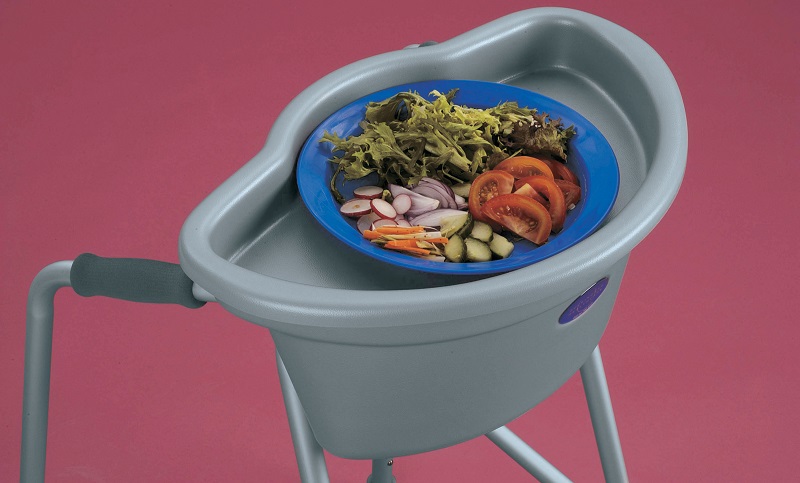
She was very self-determined and lived alone with little community support. We undertook the usual rehabilitation and worked on getting her to walk again and manage her personal care, initially with a zimmer frame.
She could cope very well with everything she was doing at home, but she had a step from her kitchen into her lounge. This meant that she would have to abandon the zimmer frame in order to carry her food, so we implemented a care package to help with mealtimes.
Unfortunately, in her eyes, the carer took over, so she sacked them within days of discharge. As a fiercely independent woman who could still do a lot for herself, she thought she could manage alone. Unsurprisingly, she came back into the hospital having fallen again and fracturing her other hip.
It really knocked her confidence – she was a witty and smart woman who just needed adjustments. I was frustrated that there wasn’t a simple device that enabled her to carry her food independently and set about trying to solve the problem for her.
My solution was low-tech – a zimmer frame with a tray drilled into it. It may have been crude, but it worked – she was able to be independent at home again and not only cook but carry her food relatively safely.
She also accepted a lift to a weekly luncheon club and even started venturing out more once she was more mobile.
At that time, my husband got his first (and only) bonus from work, so I asked him if I could use some of the money (instead of buying the car he wanted!) to make the product real. Although he thought it was a rubbish idea, he did agree.
We visited a designer and made a basic wooden version of the caddy. We went to a tradeshow to see what people thought of it and we were absolutely blown away by the positive response from the clinicians so we went on to manufacture the caddy.
Creating more products to solve problems was a natural progression from there. All occupational therapists and physical therapists are inherent problem solvers, it is an essential core skill.
You’re forever thinking: “This isn’t right – there has got to be a better way of doing it.” So every single product we’ve made is based on real people that I have worked with. Every product exists because there’s been a particular person with a story and need.
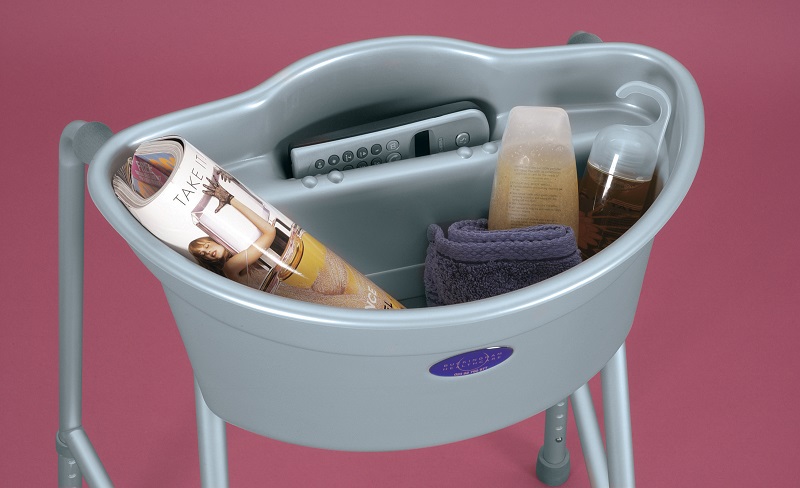
Tell us about Buckingham Healthcare and the products you design and sell.
We officially established Buckingham Healthcare in 2001 and I continued to work in the NHS until about eight years ago. My main role within the company is inventing new products based on my clinical experiences. I am responsible for research and design and project management.
I provide clinical insight into the designs and I work alongside user groups and other therapy clinicians to ensure our designs meet the needs of the people that buy them.
We’ve been in business for more than 20 years and our products are now sold across the world. We’ve created a wide range of disability living aids, from bathroom to kitchen aids, such as the Easywipe bottom wiper range and Coolhand plate holder, equipment to help around the home – including the Foldeasy folding toilet frame – and dressing aids, such as the BraBuddy bra fastening aid (see below).
We also manufacture products designed by other inventors – including Duncan the Disability Horizons Shop manager and his Trabasack wheelchair lap trays.
We are currently working on three new projects, one of which is the Glideboard and a result of our success in being awarded a UK government innovation grant alongside the Orthopaedic Research Unit at the University of Bournemouth.
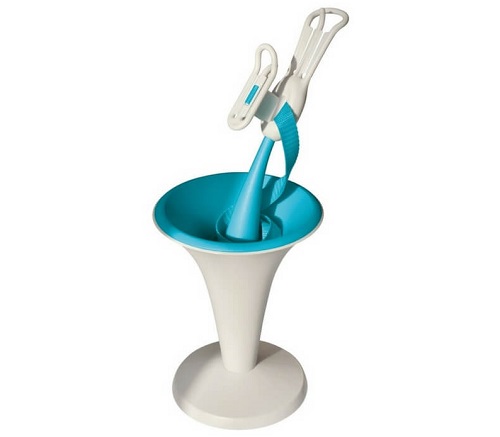
See the range of Buckingham Healthcare products on the Disability Horizons Shop.
Tell us about how the idea for the Glideboard came about and how you started to put it into production.
It’s actually a product that I have had in mind for 15 or so years but have never had to funds to properly research and develop a solution. With most patients that I saw in the wheelchair clinics, transferring always meant a great amount of lifting, dragging and pulling.
I also often dealt with people with very complex disabilities, including children. I saw so many families struggle day-to-day, so I was constantly thinking: “What if there was a bit of equipment that helped that transfer for both the user and the carer.
For a long time, I couldn’t work out how to deal with those problems. But in 2019, through Buckingham Healthcare, I applied for and won an open competition and was awarded an Innovate UK Smart Grant to research current transfer boards and the various designs available.
The purpose of the award was to design a new inclusive and highly functional transfer board that is a vast improvement on what is currently out there.
We wanted it to be stable, lightweight and easy to use, as well as to reduce carer and patient effort when transferring from a wheelchair to a variety of surfaces.
To assist in this project, I enlisted the services of the highly acclaimed Orthopaedic Research Institute at Bournemouth University and its specialists in the scientific movement of people.
It was the first time I have ever been able to evaluate all the products in the marketplace and design a new shape from scratch. The grant is time-restricted and the funds enabled us to work through the research and design at a fast and focused pace.
In addition, I was fortunate to bring OTs and specialists in moving and handling from Salisbury Hospital Spinal Unit on board, along with Community Therapists from Wimborne and Portsmouth Social Services.
The project commenced in February 2019 and managed to progress through 2020 even though the country was swamped in the depths of the Covid-19 pandemic.
The lockdown and restrictions presented numerous unforeseen challenges at the outset, one of which was not being able to get wheelchair users to also try out the prototypes – something I was keen to do.
Now, after years of thinking about it and working with so many experts, we’ve finally been able to produce the new Buckingham Glideboard, all researched, designed and manufactured in the UK. We launched it last week at Naidex, exclusively on the Disability Horizons Shop.
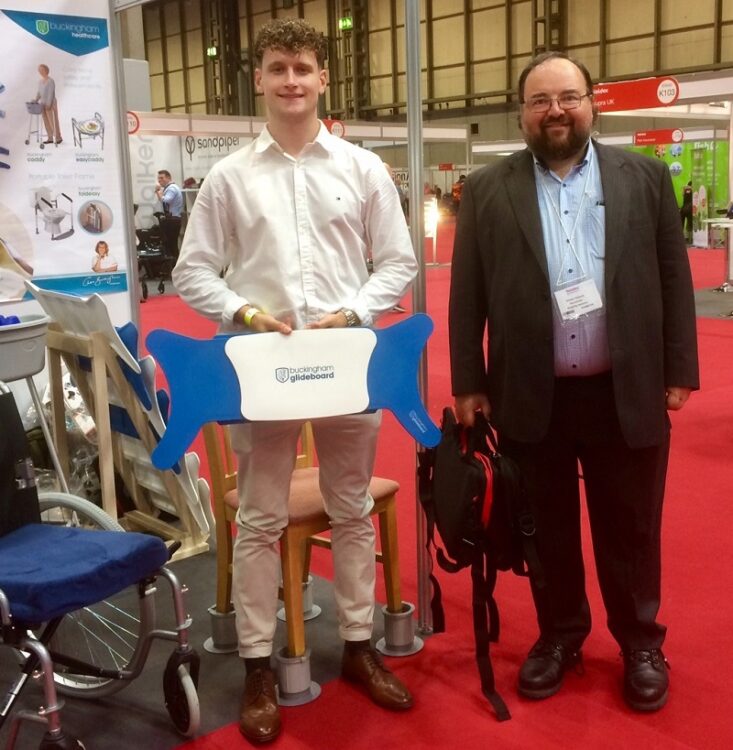
With a weight limit of 20 stone, the scientific asymmetrical design offers a multitude of transfer options, making it the most stable transfer board available.
The gliding seat has been laboratory proven to reduce the effort required by a carer or the user by up to 31% easier compared with boards without a sliding seat.
Key features and benefits of the Buckingham Glideboard are:
- Lightweight, strong and stable
- Easy to insert and remove, and quick to use
- Offers multi-use from different surfaces and in different situations
- Specially designed handles that facilitate a wide range of positioning and situations
- Easy to clean with no dirt traps and the seat can be removed easily
- Bright and attractive design, with a range of colours (plus more patterns to follow).
We really believe this board will make a massive difference in people’s lives.
Head to the Disability Horizons Shop NOW to buy the innovative Glideboard.
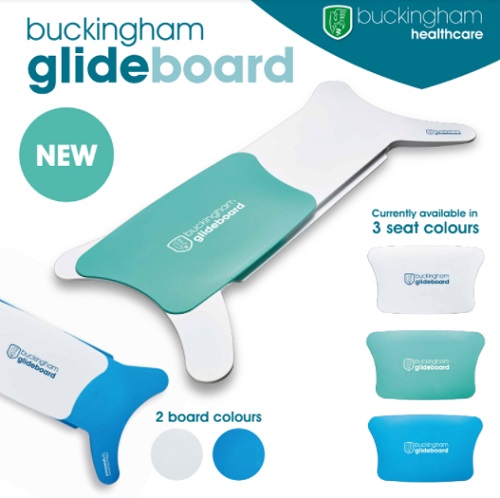
We’re also working on a second model that has a greater weight limit. Hopefully, that will be manufactured next year in 2022.
Early this year we applied for and won another Innovate UK competition and this time our focus is to develop a safe wheelchair to toilet transfer device that can be used at home and in the community.
Again, in partnership with the Orthopaedic Research Institute at Bournemouth University, I’m asking wheelchair users, carers for wheelchair users and clinicians who work with wheelchair users to fill in our survey on the problems people experience when transferring.
I firmly believe that the right people – experts and disabled people themselves – should be involved in the design stage of a product to make it valuable.
The survey will only take 15 minutes and you could be in with a chance of winning £50 to use on the Disability Horizons Shop.
If you have bought a Glideboard from the Disability Horizons Shop, please do get in touch to let us know if you have any feedback. Email shop@disabilityhorizons.com.
By Chris – founder of Buckingham Healthcare
More on Disability Horizons…
- 10 daily solutions to make life easier if you’re disabled
- How Hannah Ensor used her disabilities to create a business
- 8 disability living aids to help with everyday tasks at home
- How disabled entrepreneur Carina used her experiences to build her own business
Originally posted on 02/10/2021 @ 9:01 am
